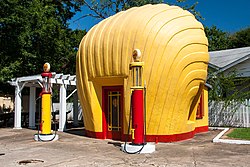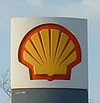
Old Salem is a historic district of Winston-Salem, North Carolina, United States, which was originally settled by the Moravian community in 1766. It features a living-history museum which interprets the restored Moravian community. The non-profit organization began its work in 1950, although some private residents had restored buildings earlier. As the Old Salem Historic District, it was declared a National Historic Landmark (NHL) in 1966, and expanded fifty years later. The district showcases the culture of the Moravian settlement in the Province of North Carolina during the colonial 18th century and post-statehood 19th century via its communal buildings, churches, houses and shops.
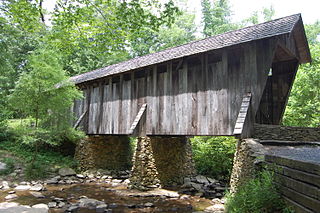
Pisgah Covered Bridge is a wooden covered bridge that spans the west fork of the Little River in Randolph County, North Carolina. It is one of two remaining original historic covered bridges in the state, and is designated as both a local and federal historic landmark.
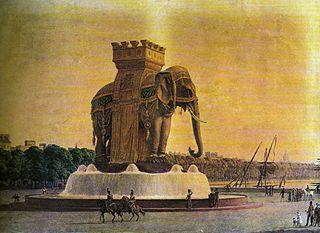
Novelty architecture, also called programmatic architecture or mimetic architecture, is a type of architecture in which buildings and other structures are given unusual shapes for purposes such as advertising or to copy other famous buildings without any intention of being authentic. Their size and novelty means that they often serve as landmarks. They are distinct from architectural follies, in that novelty architecture is essentially usable buildings in eccentric form whereas follies are non-usable, purely ornamental buildings also often in eccentric form.

The Teapot Dome Service Station is a former gas station built in the shape of a teapot located in Zillah, Washington, United States, that is listed on the National Register of Historic Places.

Paul Bunyan and Babe the Blue Ox are the names of a pair of large statues of the American folk hero Paul Bunyan and his ox, located in Bemidji, Minnesota. This roadside attraction has been listed on the National Register of Historic Places since 1988.

The Airplane Service Station, also known as the Powell Airplane, is a service station built in 1930 in the shape of an airplane. Located at 6829 Clinton Highway in Powell, an unincorporated community in Knox County, Tennessee, it is on the National Register of Historic Places.

Rockford is an unincorporated community and former town in southern Surry County, North Carolina, United States.

The Nissen Building is a 283 ft 18-story skyscraper in Winston-Salem, Forsyth County, North Carolina, built in 1927. It was the largest building in the city, succeeding the Hotel Robert E. Lee, and the tallest building in North Carolina from 1927 to 1929, when it was succeeded by the Reynolds Building; all three buildings were in Winston-Salem. The Nissen Building was named to the National Register of Historic Places March 17, 1983, with a boundary increase in 2004 to include a one-story addition built in 1969. With the spire on top, its height is 102.1m.
Shell Service Station may refer to:
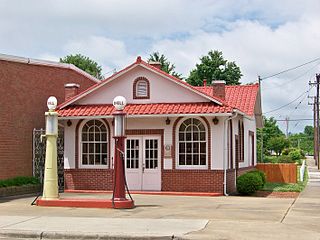
Beam's Shell Service Station and Office, also known as C. Grier Beam Truck Museum, is a historic service station located at 117 N. Mountain St. in Cherryville, Gaston County, North Carolina. It was built about 1930 by the Shell Oil Company, and is a one-story, rectangular Mission/spanish Revival style building. Associated with the service station are the original pump island and gasoline pumps.
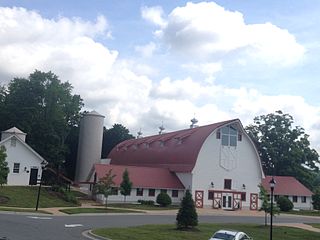
Win-Mock Farm Dairy is a historic dairy complex located at Bermuda Run, Davie County, North Carolina, USA. The complex was built about 1930 and includes a dairy barn, bottling plant, granary, cistern and water trough. The barn is a two-story frame building that measures 38 feet, 3 inches, in width by 180 feet in length. It has a concrete foundation, wood German-siding and a Gothic arch roof.

James Mitchell Rogers House is a historic home located at Winston-Salem, Forsyth County, North Carolina. It was built between 1883 and 1885, and is a large two-story, eclectic Late Victorian frame dwelling. The house design reflects Late Gothic Revival, Italianate, and Queen Anne style design influences. It features steeply pitched gables sheathed in board and batten siding, bay windows, and irregular massing. It was the home of James Mitchell Rogers, a prominent Winston-Salem businessman, and his son, Francis Mitchell Rogers, chief chemist of Standard Oil Company of Indiana.
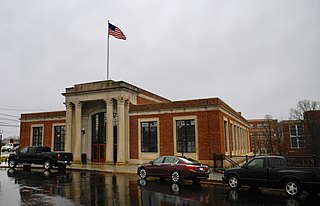
Union Station is a historic train station, currently serving as a bus station, located in Winston-Salem, Forsyth County, North Carolina.

Winston-Salem Southbound Railway Freight Warehouse and Office is a historic railway freight warehouse and office building located at Winston-Salem, Forsyth County, North Carolina. It was built in 1913, and is a two-story, brick railroad building with a shallow gable roof and Italianate-style design elements. It measures 40 feet by 224 feet. The building served until 1985 as headquarters for the Winston-Salem Southbound Railway. In 1990, the building was sympathetically renovated for office use.

Salem Town Hall is a historic town hall located at Winston-Salem, Forsyth County, North Carolina, United States. It was designed by architect Willard C. Northup and built in 1912. It is a two-story brick building with stone, cement and wood trim. It features a three-story corner bell tower and has Italianate and local Moravian design elements. The building housed the Salem Town offices until it consolidated with the town of Winston in 1913, then moved to the newly built Winston-Salem City Hall in 1926. The building continued to be used as a fire station until the mid 1970s. It was subsequently renovated into offices.
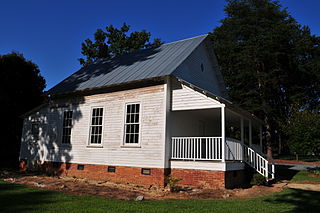
Oak Grove School is a historic one-room school for African-American students located at Winston-Salem and owned by the YWCA of Winston Salem, Forsyth County, North Carolina. It was built about 1910, and is a one-story, gable-front, in weatherboard clad building with a full-width, shed roof porch. The school closed about 1950, and was used as a store. It was restored in 1998.

Downtown North Historic District, also known as Trade Street District, is a national historic district located at Winston-Salem, Forsyth County, North Carolina, USA. The district encompasses 46 contributing buildings in a commercial section of Winston-Salem. They were built between about 1907 and 1952, and most are one- or two-story brick buildings, sometimes with a stuccoed surface. Notable buildings include the Beaux-Arts style former United States Post Office with an addition by Northup and O'Brien, Brown-Rogers-Dixson Company Building (1928), Centenary Church Education Building (1920s), Pure Oil Station, City Market (1925), and Twin City Motor Company (1925).
West End Historic District is a national historic district located at Winston-Salem, Forsyth County, North Carolina. The district encompasses 508 contributing buildings and 7 contributing structures, in a predominantly residential section of Winston-Salem. It was a planned picturesque streetcar suburb developed at the turn of the 20th century. The buildings date from about 1887 to 1930, and include notable examples of Classical Revival, Colonial Revival, Queen Anne, and Bungalow / American Craftsman style architecture. Located in the district are the separately listed H. D. Poindexter Houses and Zevely House. Other notable buildings include the St. Paul's Episcopal Church (1928-1929) designed by Ralph Adams Cram, Augsburg Lutheran Church (1926), Friends Meeting House (1927), the First Church of Christ, Scientist (1924), and Joyner's West End Grocery.

Waughtown–Belview Historic District is a national historic district located at Winston-Salem, Forsyth County, North Carolina. The district encompasses 1,137 contributing buildings, 1 contributing site, and 1 contributing object in a largely residential section of Winston-Salem. The buildings date from about 1834 to 1955, and include notable examples of Greek Revival, Colonial Revival, Queen Anne, and Bungalow / American Craftsman style architecture. Located in the district is the separately listed Shell Service Station. Other notable resources include the Clodfelter House, Fiddler House, Nissen Wagon Works smokestack, Triangle Body Works, Waughtown Baptist Church (1919), Waughtown Presbyterian Church (1914), Southside Christian Church, and Waughtown Cemetery.

Marion House and Marion Brothers Store also known as Jubal E. Marion—Richard Nathaniel Marion House and Oakcrest, is a historic home and general store located at Siloam, Surry County, North Carolina. The house was built over three periods in 1861, 1895, and 1913. It is a two-story, three-bay, double pile, Classical Revival, Southern Colonial style frame dwelling. The 1913 remodeling was by prominent Winston-Salem architect Willard C. Northup. It features a two-story, Ionic order central portico and a one-story porch with Tuscan order columns that nearly encircles the house. The Marion Brothers Store was built about 1894, and is a two-story, brick commercial building. The property also includes the contributing wash house/smokehouse, a garage with a tool room/shop and a pump room, a fish pool, a carbide house, two chicken houses, a barn, a corn crib / granary, and two tobacco barns.
